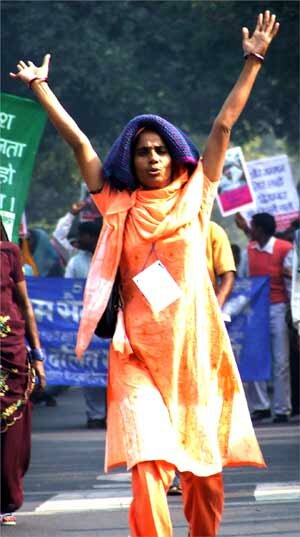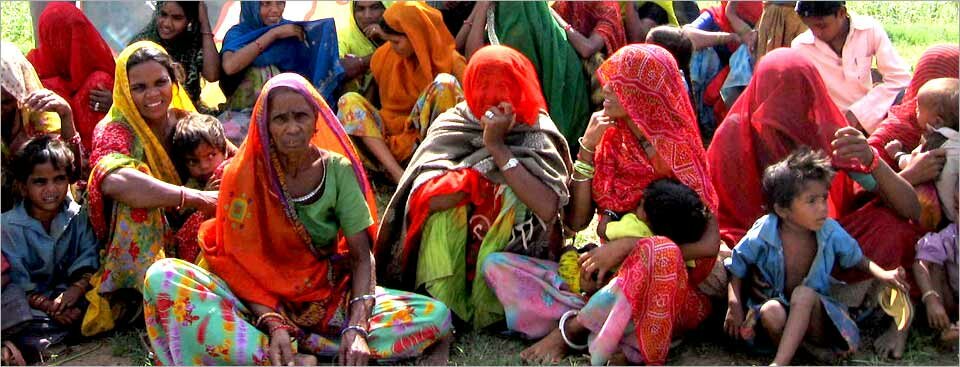Social Exclusion of Dalits: Field View
The process of exclusion of Dalits prescribed in the religious texts was implemented in letter and spirit in society. Babasaheb Dr. B.R. Ambedkar wrote, “Under the rule of the Peshwas in Maratha country the untouchable was not allowed to use the public streets if a Hindu was coming along lest he should pollute the Hindu by his shadow. The untouchable was required to have a black thread either on his wrist or on his neck as a sign or a mark to prevent the Hindus from getting themselves polluted by his touch through mistake. In Poona, the capital of the Peshwa, the untouchable was required to carry, strung from his waist, a broom to sweep away from behind the dust he treaded on lest a Hindu walking on the same should be polluted. In Poona, the untouchable was required to carry an earthen pot, hung in his neck whenever he went, for holding his spit lest his spit falling on earth should pollute a Hindu” (Ambedkar 1979: 39).
 Similarly Dr. Ambedkar argued that Balais, the second largest community of Dalits in Madhya Pradesh and then in Central India were told in 1928 that if they want to live in the village then they have to conform to certain rules - Balais must not wear gold-lace-bordered turban; they must convey intimation of the death of any Hindu to relatives of the deceased - no matter how far away these relatives may be living; In all Hindu marriages, Balais must play music before the processions and during the marriage; Balai women must not wear gold or silver ornaments; Balai women must attend all cases of confinement of Hindu women; Balai must render service without demanding remuneration and must accept whatever a Hindu is pleased to give. If the Balis do not agree to abide by these terms they must clear out of village (Ambedkar 1979:39-40). Describing the exclusion of the Shanans - a lower caste of Tamil Nadu - Rudolph & Rudolph (987:38) argued, “Shanans were not allowed to enter the compounds of temples consecrated to Brahmanical deities such as Shiva or to use wells of higher castes. At least in Travancore, they were expected to maintain a prescribed physical distance between themselves and Brahmans. In multi-caste villages, barbers and washer- men would not ordinarily serve them”.
Similarly Dr. Ambedkar argued that Balais, the second largest community of Dalits in Madhya Pradesh and then in Central India were told in 1928 that if they want to live in the village then they have to conform to certain rules - Balais must not wear gold-lace-bordered turban; they must convey intimation of the death of any Hindu to relatives of the deceased - no matter how far away these relatives may be living; In all Hindu marriages, Balais must play music before the processions and during the marriage; Balai women must not wear gold or silver ornaments; Balai women must attend all cases of confinement of Hindu women; Balai must render service without demanding remuneration and must accept whatever a Hindu is pleased to give. If the Balis do not agree to abide by these terms they must clear out of village (Ambedkar 1979:39-40). Describing the exclusion of the Shanans - a lower caste of Tamil Nadu - Rudolph & Rudolph (987:38) argued, “Shanans were not allowed to enter the compounds of temples consecrated to Brahmanical deities such as Shiva or to use wells of higher castes. At least in Travancore, they were expected to maintain a prescribed physical distance between themselves and Brahmans. In multi-caste villages, barbers and washer- men would not ordinarily serve them”.
Apart from community as a whole, the exclusion and exploitation of the Dalit women in the name of religion is also a fact. In this context, Gail Omvedt argues that, “the Dalit girls were dedicated to the goddess Yellama/Renuk… Following this ‘marriage to the god’ most of the girls remained in their own village; they were considered accessible to any men but at the same time not bound to or polluted or pollute by sexual relations…These girls were as ‘Murali’ among Mahars, ‘Matangi’ among the Madigas and ‘Basavi’ among Holeyas… it also helped to institutionalize the sexual accessibility of the Dalit women for higher caste men (Omvedt 1994:72). Briggs has also highlighted the vulnerable condition of Dalit women in his study of Chamars – the most numerous Dalit Community in India. He wrote in 1920s, “There are other social customs, more or less objected to but often allowed and not considered wrong, which are gradually disappearing under modern conditions. Such are the just prima notices of landlords and gurus. The Zamindar often has liberties with Chamar’s wife in consideration of his payments to the Chamar. The Sais’s wife gives immoral services where her husband is employed in the towns or cities” (Briggs 1920:43). Further in Tamil Nadu Rudolph & Rudolph (1987:39) have also revealed the pathetic condition of Shanan women in the area. They argued that a riot broke out in 1858 when Shanan women emulated to cover their breasts like locally dominant Nair caste. The next year, Sir Charles Terevelyan, the governor of Madras, granted them permission to wear a cloth over their breasts and shoulders.
Dalits have become conscious of their persona and are rejecting advances of the upper castes that humiliate them. In many places, rejection of such advances results in violence against the Dalits. But, Dalits have come of the view that it is better to object, reject and fight than continue to tolerate humiliation and indignity. This confident assertion of dignified living and equal dignity of all give hopes that finally the Dalits would have autonomy over their body, decision and whatever meager assets they might have.

